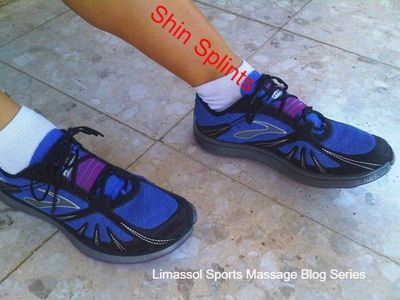|
Shin Splints can make your training programme a misery, read on for some tips to help combat this condition. Debilitating and painful, shin splints tend to come on when we have increased the demands of our training without pre-conditioning our lower leg muscles. Runners often suffer if they increase their mileage on hard ground, or up hills too quickly. Walkers can suffer with sudden increases in distances. Gym users who suddenly perform lots of explosive movements and 'on your toes' type exercises can get this condition. In mild cases it can feel like tenderness across the front of the shin that temporarily eases off with movement. In extreme cases, it can lead to fractures of the surface of the tibia (the load bearing lower leg bone). In fact, we have seen swellings the size of an egg on shins where this has unfortunately been the case. When shin splints present in such an extreme manner, complete rest from activity is required. In milder cases, and remember that catching sports injuries as early as possible is key, there are a few things that you can do to help with a smoother recovery. As soon as you feel tenderness across the front of the shin, try to rest from the activity that triggered it. A smaller rest at this point could save you from a much longer rest due to the condition deteriorating. Think about changing your sport for a while, or at least altering some aspects of your sport. It is best to avoid high impact activity until symptoms subside. When you have a sports injury type niggle, you have three options; to stop whatever is causing you a problem, to modify the activity, or to try and deal with the symptoms (the latter works best if you catch the injury sooner rather than later). Taping the Tibialis anterior muscle can be a good option too. Zinc oxide tape can be used to draw the muscle away from the shin bone in a spiral fashion during rest phases. If exercise continues, the elastic therapeutic taping methods are better. Speak to us in Clinic about which method will suit you better. Stretching the Tibialis anterior muscle is very helpful. Sit on your heels in a kneeling position for 20 seconds. Try this for two weeks at least 5 times per day. There are more advanced versions of this stretch available too. Sports Massage Therapy is ideal for this condition. Releasing the muscles in the lower leg and using specialist techniques to stretch the Tibialis anterior muscle is very helpful. Try at least three sessions over two weeks and follow the home-care advice carefully for optimal results. Try some ice therapy in acute phases. Just 10 minutes at a time on a small localised area a few times a day. This is especially useful post activity. Pre sports, apply a warm compress to allow the muscle to soften and relax a little. When you are symptom free in walking for at least two weeks, you can go ahead and slowly reintroduce some exercise in moderation. Do not do too much, too soon or too fast as your symptoms will return very quickly. When you are back to very light training and symptoms are symptoms are not present at all, you can add some very basic strengthening exercises. Be aware that rehabilitation exercises are very different to training exercises and they may appear to be easy for you but that is okay. Speak to a Personal Trainer with a rehabilitation qualification for assistance. Try toe raises whilst sitting. Aim for 10 raises per day for two weeks and when this goes well, without symptoms, move on to two sets from week three onwards. Calf raises can also be helpful, do these without weights and be extra careful to build up slowly. Try 5 slow raises on two legs for two weeks. If symptom free move on to single leg raises from week three onward. As always prevention is better than cure. Be hyper vigilant for small aches and pains, watch out for any tender areas and allow enough recovery time so you have a better chance of keeping repetitive injury free. AuthorEva Evangelou, BA Hons, PGCE, Adv Diploma, ITEC & IFA Dips, is the UK Qualified Sports Massage Therapist behind Limassol Sports Massage. Being a Qualified Sports Massage Therapist has given her extensive training and experience in Injury Prevention, the Theory of Training and Injury Rehabilitation. She has been a Body Worker since 2004. Eva has run 3 full Marathons including Nicosia, Rome and the Limassol Marathon. She is usually injury free and believes that prevention via education is better than cure. She is the Author behind 'Say No! To Neck and Shoulder Pain' and she is a Qualified Teacher. Learn more about her at www.LimassolSportsMassage.com and contact her via [email protected] |
AuthorSports Massage Therapist, Wellness Advocate, Sports Enthusiast, Teacher, Nutritarian, Blogger, Artist and much more... Archives
October 2022
Categories
All
|



 RSS Feed
RSS Feed